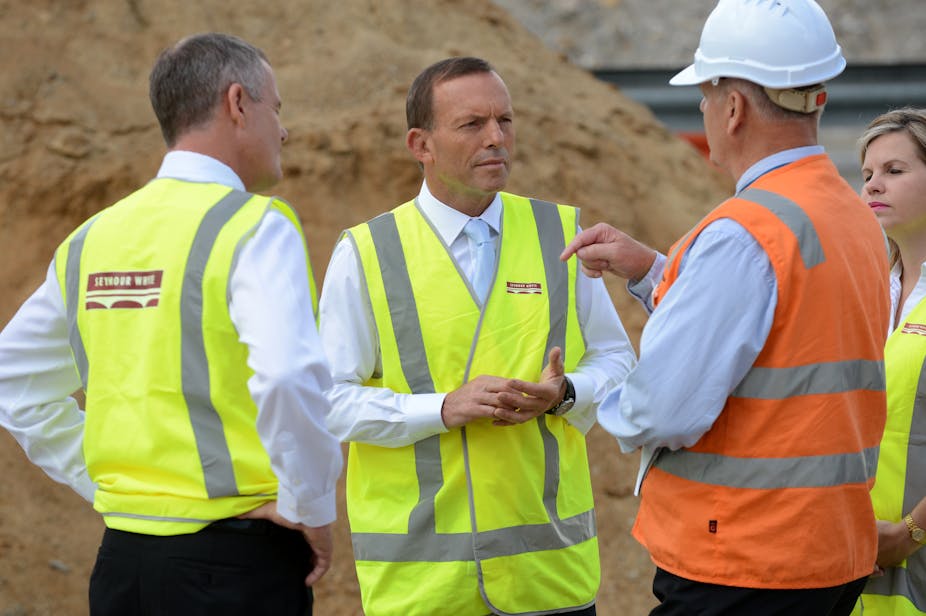One of the many challenges facing the Australian economy over the next decade or two concerns investment in transport, electricity, water, communications, health and education, and other infrastructure. Some estimates point to gaps of hundreds of billions of dollars.
Tony Abbott often declares an interest in being the “infrastructure prime minister”, and a number of new projects were promised in the May 2014 federal budget. The current strategy for choosing infrastructure projects reflects a more ad hoc, opaque and heavily political driven strategy, rather than an informed and transparent approach with bipartisan support.
Further, a revised blueprint would facilitate the funding of those infrastructure projects which contribute most to greater national productivity and higher living standards.
Investment in infrastructure involves costs today for benefits in the future. The costs require reallocating labour, capital and natural resource inputs from the production of goods and services for current consumption. In time, better transport, buildings, communications and so forth lower production costs for businesses and they provide direct benefits to households. Infrastructure investment might be considered an inter-generation transfer.
Many government-funded infrastructure projects will be self-funded over the life of the project. For example, the extra quantities and better qualities of water, electricity, communications and utility services generate a larger future stream of larger revenues collected from sales of the additional services. Less direct, but still significant, is the extra government revenue generated by investment in transport infrastructure, including from fuel excise and motor vehicle registration fees, and from additional income, consumption and other taxes collected from the larger tax bases of a more productive economy.
Whether the Commonwealth can drive infrastructure is a focus of the Economic and Social Outlook conference in Melbourne this week, and such a debate is needed. A formal, transparent and public assessment of the time path of benefits and costs, and of the revenues and outlays, should be undertaken for each infrastructure investment proposal.
Only with this information can the highest priority projects in terms of contribution to improved national outcomes and living standards be identified. Ideally, the project assessments would be undertaken by a body funded by, but independent of, government. One aspect of the evaluation process would allow for community consultation, perhaps via a draft report.
Claims that the results of such reports cannot be made public, including current statements of “business in confidence”, have little merit. Usually the public are advised of costs, which often come from potential private sector constructors. A condition for businesses tendering for construction could include public release of broad cost numbers.
In general, the benefits of infrastructure projects are assessed by public servants. Current restrictions on the release of analyses undertaken by Infrastructure Australia and by state agencies are not conducive to informed public debate, longer term confidence in governments, or the most effective use of limited infrastructure investment dollars.
Clearly, many of the details of any investment project, including in infrastructure, are debatable and open to legitimate alternatives which can significantly change the priority ranking of different infrastructure projects. For example, varying choices of the discount rate and different estimates of the numbers of future users and of their valuations of additional services provided will alter estimated project benefit-cost outcomes. Ultimately, the government of the day has to recognise uncertainty and make a final decision.
Proposed infrastructure investment projects supported by a public evaluation which demonstrates net national benefits, and in many cases also a net positive cash flow for government, could be funded with increased government debt. The extra receipts from the additional services provided, together with greater taxation collected from a larger economy, means that the future generation beneficiaries also repay the debt and interest expenses over the life of the investment. That is, public funded infrastructure would be treated in much the same way as private sector investment by businesses and households.
Australia’s federal system of government raises some additional issues for the funding of infrastructure. Constitutional responsibility and convention mean that the states (and territories) are responsible for the construction and operation of the majority of infrastructure. But the Commonwealth has carriage of over 80% of the tax revenue collected.
The larger the share of the benefits of infrastructure reflected in higher incomes relative to specific fee charges, the larger the share of benefits of the infrastructure investment that accrue to the Commonwealth, rather than the states. For these infrastructure investments, a proportionate share of the initial investment outlay should lie with the Commonwealth, with a generally agreed set of principles of cooperation.
Because infrastructure involve investments with a productive life spanning many decades, ideally, any revised general strategy affecting the priority listing of projects and the funding strategy would have bipartisan support. This still leaves room for party influence on, and responsibility for, the details of particular projects.
The 2014 Economic and Social Outlook conference, hosted by the Melbourne Institute, will be held in Melbourne on Thursday, July 3 and Friday, July 4.
The Future of Infrastructure opens on 19th August in Melbourne.

